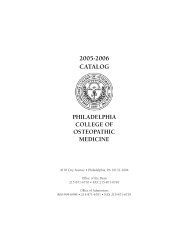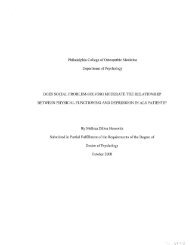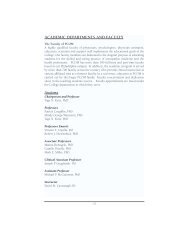0 - Philadelphia College of Osteopathic Medicine
0 - Philadelphia College of Osteopathic Medicine
0 - Philadelphia College of Osteopathic Medicine
Create successful ePaper yourself
Turn your PDF publications into a flip-book with our unique Google optimized e-Paper software.
Biopsychosocia1 Effects Among Coronary Artery Bypass Grafting Patients 51<br />
these two instruments may not be measuring similar constructs. A larger sample size may<br />
also be a confounder, limiting the ability to pick up relationships between these variables<br />
that may be more sensitive to detect true effects.<br />
This research also investigated the independent measure <strong>of</strong> coping by assessing<br />
the relationship between The Brief Cope-Problem Focused Scale and dependent measures<br />
pain (MPQ) and depression (BDI-II). In the literature many studies show relationships<br />
between coping style and the predictors (pain & depression) among cardiac patients<br />
(Macrae, 2001; Welke et aI., 2003; Hallas et aI., 2003; Hirani & Newman, 2005).<br />
There was an approaching-significant correlation between The Brief Cope<br />
Problem Focused Scale and The MacNew Heart Disease Health Related Quality <strong>of</strong> Life<br />
Questionnaire. It can be assumed that with a larger sample size a relationship may have<br />
been detected. These measures are assumed to measure similar construct and it is likely<br />
they share an overall relationship.<br />
However, it is unexpected to find no significant relationship between these<br />
constructs. One explanation, as suggested previously, may be due to sampling bias.<br />
Individuals who experienced high levels <strong>of</strong> pain or depression, or both may not have<br />
participated in the study as shown in moderators like class, age, or sex.<br />
Research suggests that demographics playa role in the recovery <strong>of</strong> CABG<br />
patients; thus patient bias may be the reason for this finding (Clark et ai., 1999; Williams<br />
et aI., 2003; Karleson & Nazroo, 2002). Demographics indicate that participants were<br />
predominantly middles class, married, with two years <strong>of</strong> education. Without support,<br />
means, or resources many participants were unable to volunteer. In addition, the sample<br />
size may have been too small to detect a significant relationship.<br />
A significant positive relationship was found between The Brief Cope-Emotion






